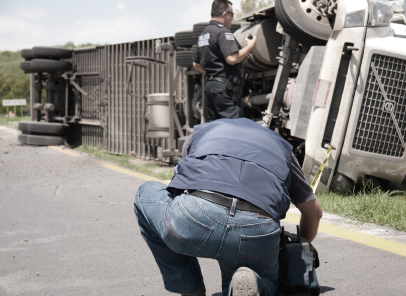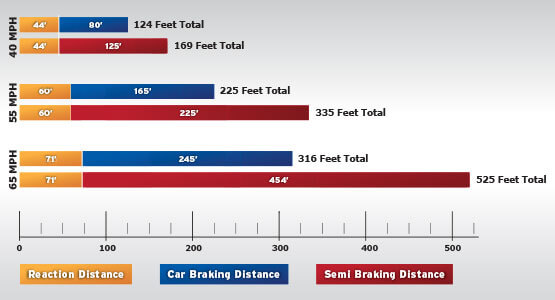Most rear-end collisions are entirely preventable with proper training and safe driving.

So why does this type of crash happen so often? It is my experience that rear-end collisions are often a failure of truck drivers to:
- maintain a safe following distance;
- operate their trucks at a proper speed for the traffic, road and weather conditions; and/or,
- consider stopping distances.
In order to avoid rear-end collisions, truck drivers need to understand stopping distances.
Stopping distance” is simply the distance necessary to bring a heavy truck to a complete stop. The distance it takes to stop an 80,000-pound tractor-trailer at 65 mph is much greater than the distance needed to stop a passenger car at the same speed.
A fully loaded truck
traveling in good road conditions at highway speeds
needs a distance of nearly two football fields to stop.
Recommended Article: Low Speed Rear-End Collision Settlement
What affects a semi truck’s stopping distance?
There are many factors that must be taken into consideration in order to determine stopping distances.
1) The decision-making process. in other words, the time, no matter how small, it takes for a driver to physically react after the decision to stop. This is commonly referred to as “perception-reaction time.”
2) The braking system on the truck and trailer. With most air brake systems, there is a momentary delay in the actual activation of the brakes. This is called “brake lag.”
3) The road and weather conditions. Obviously, it takes longer for a semi-truck to stop on a wet or icy road. The larger the truck and heavier the load, the more time it will take to stop.
4) The speed and rate of travel. As speed increases, so does the stopping distance.
5). The following distance. The less space tractor-trailers have from the vehicles ahead, the less space they have to stop without causing rear-end collisions.
What do you consider a safe following distance?
For semi-trucks, it starts with a safe stopping distance: perception + reaction + braking.
See: The art and science of trucking: a safe following distance
Originally posted 10-28-11, this post has been updated with additional information. Please note that most rear-end collisions are not “accidents”; they are predictable, preventable crashes. That’s why we use the word “collision” instead of “accident” in this post and others on TruckingWatchdog.com.
Recommended Article: Where Do Broadside Collisions Most Commonly Occur?





